|
|
|
Sort Order |
|
|
|
Items / Page
|
|
|
|
|
|
|
| Srl | Item |
| 1 |
ID:
193294
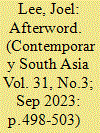

|
|
|
|
|
| Summary/Abstract |
This afterword critically engages with the introduction and five essays of this special section on Muslim caste associations, illuminating their distinctive contributions and posing questions toward the further development of a collective research agenda.
|
|
|
|
|
|
|
|
|
|
|
|
|
|
|
|
| 2 |
ID:
193293
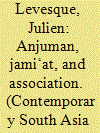

|
|
|
|
|
| Summary/Abstract |
In the early decades of the twentieth century in colonial India, the development of education, the expansion of electoral politics, and the decennial censuses led many caste communities, or ‘caste groups’, to organize collectively in search of internal solidarity and public assertion. Informed by the notions of service and reform, Muslims participated in this new associationism. Among them, the Sayyids – a privileged status group that claims descent from Prophet Muhammad – also formed their organizations. This article compares three Sayyid organizations in India and Pakistan, with two principal aims. First, it brings out the implicit notions of inclusion and exclusion that inform the functioning of the organizations as they seek community preservation. Second, it draws broader conclusions about associational forms available to South Asian Muslims when they act collectively on the basis of a shared social status or caste. The article concludes by delineating three ‘organizational models’ that Muslim caste groups can draw upon – the anjuman, the jami‘at, and the association. Overall, this article illustrates how Muslims frame practices of social distinction in an Islamic language of equality, piety, or service.
|
|
|
|
|
|
|
|
|
|
|
|
|
|
|
|
| 3 |
ID:
193292


|
|
|
|
|
| Summary/Abstract |
The article analyses the ways in which low-ranked Muslims mobilise collective terms for self-identification to avail preferential state policies (reservations). Specifically, it focuses on the strategies deployed by the Bhishtis, a caste group associated with carrying water, to be listed as Other Backward Classes (OBC) and claim municipal sanitation work as ‘safāī karamchārī’. Reservation policies are instrumental in shaping the Bhishtis' demands and social positions. They reproduce caste-based division of labour and accentuate internal cleavages within the community. While distancing themselves from elite emulation (Ashrafisation), the Bhishti simultaneously deploy caste-based and Islamic identities in their quest for material gains. Caste identity is used instrumentally vis-à-vis the state to avail OBC reservation and demand municipal sanitation jobs. Additionally, it functions as an oppositional identity towards upper class elites within the community. Islamic identity emphasises a work ethic and dignified labour, and enabled criticism of the state for practicing religious discrimination when a commitment to Bhishti employment was officially removed from the sanitation department. Internally, the Islamic identity helps keep the various factions within the community united. In fact, local articulations of birādarī identity evolve across space and time, questioning whether it is fruitful to talk about birādarī and caste.
|
|
|
|
|
|
|
|
|
|
|
|
|
|
|
|
| 4 |
ID:
193287
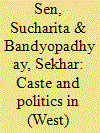

|
|
|
|
|
| Summary/Abstract |
Although many commentators believed that caste did not matter in West Bengal, in recent years it has emerged as a significant factor in electoral politics. The decline of the Left and the rise of the centrist-incumbent have fanned identity politics and the resurgence of caste-based political mobilisation. In this conversation, Sekhar Bandyopadhyay, a well-known expert in the history and politics of caste in Bengal, illuminates the complexities, uniqueness and dynamics of caste politics in colonial Bengal and contemporary West Bengal. The interview explores the evolution of the caste-system in colonial Bengal, its differences with the rest of India and the multiple manifestations of caste-based politics in contemporary West Bengal. Bandyopadhyay reflects on the intersection of caste with other categories of class and religion, the lower-castes’ involvement, appropriation and neglect in the political spectrum, and the future of caste and politics in West Bengal.
|
|
|
|
|
|
|
|
|
|
|
|
|
|
|
|
| 5 |
ID:
193288
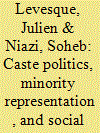

|
|
|
|
|
| Summary/Abstract |
Social stratification among Muslims in South Asia, specifically the phenomenon of Muslim caste, has recently gained scholarly and media attention, particularly in India. However, the public discussion – often empirically shallow and politically polarized – fails to adequately explain the mechanisms through which Muslims perpetuate social inequality while invoking egalitarian principles. This special section, based on a panel held at the 2022 BASAS annual conference, aims to contribute to the scholarly and public discourse by advocating for the study of Muslim caste associations. Taking the associational life of caste into account provides a tangible object of study. Moreover, it shifts the focus away from macro-level discussions towards an empirically grounded analysis at the meso- and micro-levels. This introduction explores two central aspects. First, we suggest that caste associations offer a fresh perspective on the study of Muslim social mobility, beyond the oft-assumed imitation of dominant caste groups or Ashrafization. Second, documenting caste associations helps us understand the diversity of Muslim representation, specifically, the tension between Muslim minority politics and Muslim caste politics. Overall, this special section provides multiple examples of Muslims’ associational engagements with caste, which encompass endeavours as diverse as political assertion, declassing, social exclusion, or universal charitable aspirations.
|
|
|
|
|
|
|
|
|
|
|
|
|
|
|
|
| 6 |
ID:
193284
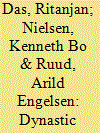

|
|
|
|
|
| Summary/Abstract |
This article contributes to the growing literature on political dynasticism in contemporary South Asia and shifts the focus from the much-debated national level dynasties to the usually ignored dynasties operating at subnational and regional levels. Analytically, it investigates the ‘moment’ of succession, conceptualised as the period when new heirs are actively enrolled in a dynastic formation. Such moments of succession can be perilous moments for dynastic formations, potentially disrupting its routine functioning style. And yet, these moments allow a clear identification and opportunity for analysis of the specific dilemma that all political dynasties have to negotiate. This dilemma can be described as follows: how to reconcile (1) the need to project emerging dynastic heirs as extraordinary beings embodying the special qualities of the original dynast, with (2) the equally pressing need to downplay inherited dynastic privilege – conceptualised here using Louis Dumont’s idea of ‘shamefacedness’ – often portrayed as an illegitimate source of power and influence in postcolonial South Asia. A successful succession, as this article argues, relies on the ability to negotiate this dilemma. To demonstrate this negotiation in practice, the article analyses two cases of dynastic succession: Abhishek Banerjee in West Bengal, India and Serniabat Sadiq Abdullah in Barishal, Bangladesh.
|
|
|
|
|
|
|
|
|
|
|
|
|
|
|
|
| 7 |
ID:
193286


|
|
|
|
|
| Summary/Abstract |
Ragging in Sri Lanka is a longstanding initiation ritual, similar to hazing and bullying. The severe harassment of new students by seniors has led to adverse consequences including depression, university dropouts and suicide. Although, a significant problem, research on ragging is scarce. This research aimed to explore how staff and work-affiliated individuals at Jaffna University resonate around the phenomenon of ragging. Seven focus group discussions and eleven semi-structured interviews were conducted. Foucauldian Discourse Analysis and Bandura’s Moral Disengagement theory were used to interpret the data. Three main discourses reflected the context: ragging as normal and necessary, insecurity and fear of reprisal, and voices of resistance. Participants often felt unsupported and therefore adapted their moral compasses to survive in this insecure environment. These findings demonstrate a fragmented approach to ragging that not only diminished any efforts towards elimination but affected how staff were forced to adjust their behavior to work in this environment. To address ragging, there is a need to adhere to a consistent strategy focusing on increasing awareness and supporting staff by holding accountable those at all levels of the administrative hierarchy in promoting a safe working environment for all.
|
|
|
|
|
|
|
|
|
|
|
|
|
|
|
|
| 8 |
ID:
193291


|
|
|
|
|
| Summary/Abstract |
This article seeks to make sense of the collective mobilisation of sanitation workers, who mainly belong to the Sheikh caste, in Kashmir’s capital Srinagar. Based on ethnographic fieldwork and interviews, I document how two organisations—the sanitation workers’ union and the All Jammu and Kashmir Pasmanda Tabqajat Federation—pursue a politics of dignity to counter the historical and systemic discrimination that the Sheikhs have traditionally faced. I highlight the differences between the two organisations. While the former mainly focuses on work-related issues, the latter seeks to translate the politics of Pasmanda assertion in the Kashmiri context. In this process, it struggles to bring about political solidarity across Pasmanda caste groups. Overall, this article also suggests that the Sheikhs’ endeavour to counter invisibilisation fractures the notion of a homogenous Kashmiri Muslim population protesting only against occupation.
|
|
|
|
|
|
|
|
|
|
|
|
|
|
|
|
| 9 |
ID:
193289
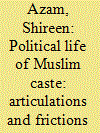

|
|
|
|
|
| Summary/Abstract |
The topic of Muslim caste has been getting space in media discourse and national politics recently through the concept of ‘Pasmanda’ – a term which refers to lower-caste Muslims. As the term gets wider purchase, it is important to question the concept and the category. What is the relationship of the category of Pasmanda with Muslim caste? Which struggles of Muslim lower castes is the term Pasmanda able to lend voice to, and what are the tensions encompassing the category. Through ethnographic fieldwork conducted in Varanasi, Uttar Pradesh, I examine a newly established organisation called the Pasmanda Adhikār Manch to explore how different single-caste associations come together under the Pasmanda banner. The caste-associations of the Halalkhor, Shah, and Nanpuz communities have the difficult task of countering the invisibilisation of Muslim caste not only by the state, but by their own caste brethren. They have limited room to demand anything from the state, considering that it hardly acknowledges the existence of their caste groups and is suspicious of their political claims as Muslims. Coming together under the Pasmanda umbrella helps provide a wider platform for assertion of Muslim caste. However, the category comes with limitations that threatens to undo its purpose.
|
|
|
|
|
|
|
|
|
|
|
|
|
|
|
|
| 10 |
ID:
193285


|
|
|
|
|
| Summary/Abstract |
This paper explores the link between the prevalence of violent conflicts and the extremely low female labor force participation rates observed in South Asian countries. The Labor Force Surveys from Bangladesh, Sri Lanka, India, and Pakistan are merged with the Global Terrorism Database to estimate the effect of terrorist attacks on female labor supply. We exploit the geographical variation in exposure to violence to compare administrative units exposed to events with those not exposed. We find that for each wounded and killed person, female labor force participation falls 0.000026 and 0.0001 percentage point, respectively, while male labor force participation remains unchanged, thus widening the gender labor participation gap. We test the non-linearity of various violence effects, finding that the deterring effect is higher in administrative units with higher baseline FLFP rates. We also provide suggestive evidence that terrorism has a negative effect on the intensive margin of female labor supply.
|
|
|
|
|
|
|
|
|
|
|
|
|
|
|
|
| 11 |
ID:
193290


|
|
|
|
|
| Summary/Abstract |
This article examines the role of caste organisations in the process of social mobility of a marginalised Muslim birādarī, focusing specifically on the Rayeen (vegetable sellers) caste. The article maps the caste panchāyat, association, and Foundation, highlighting their respective role and function in the process of social mobility and political representation. I show that the various organisations complement each other in the overall process. Caste panchāyat relies on the traditional authority of the head of the caste group (the chaudharī) to regulate the internal affairs of birādarī members. The caste association attempts to consolidate the group’s collective identity and foster unity to exert influence in the electoral process. Finally, caste members also run organisations at the local level, such as the Rayeen Foundation, trying to expand the reach of their activities beyond the birādarī, appealing to universal principles. Collectively these organisations strive to claim a higher status for the Rayeens. The article’s contribution is to highlight the interactions between the multiple caste organisations in facilitating the transformation of group identity and the process of social mobility experienced by a marginalised Muslim caste group.
|
|
|
|
|
|
|
|
|
|
|
|
|
|
|
|
|
|
|
|
|